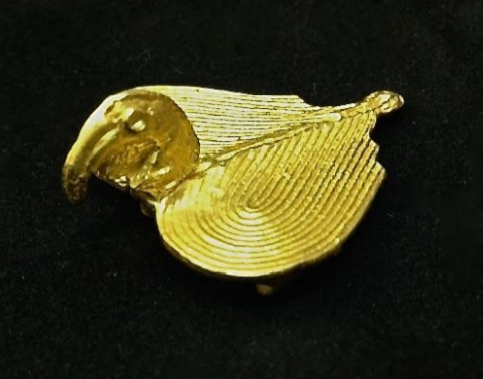This display consists of accurate reproductions of ancient, high-status pendants and pectorals produced by the artisans of the ancient Isthmian region cultures, who inhabited the area from Costa Rica down to northern Colombia. These ornaments were likely worn by the rulers and spiritual leaders of the Isthmian cultures, as the shiny, brilliant gold surfaces are known to have symbolized not only wealth, but also power and moral virtue in both the physical and the supernatural worlds.
The cultures of the Isthmian region created these elaborate ornaments using lost-wax casting and forging techniques. For the casting, a model was made in wax with some features formed by intricate wax threads, while other parts such as the wings and tails may have been made in simple rod-like shapes. The model was encased in clay and then heated to vitrify the clay and make the wax run out, and finally, molten metal was poured into the mold. After the mold was broken away, the rod shapes were forged into smooth, wide geometric shapes.
While these objects appear to be made of gold, they are actually made of tumbaga, a metal alloy of copper, gold, and silver. The cultures of the Isthmian region used a technique known as depletion gilding to create the appearance that the objects were made of solid gold. This involved repeated cycles of dipping the ornament into an acidic salt bath, then heating, cleaning, and polishing the objects until the copper and silver had dissolved from the top layers, leaving behind a thin surface of pure gold.

Colombian Mestizo cultures
Late 20th-early 21st century
Brass, L. 3.5 cm x W. 7 mm x H. 6.5 cm
BFPC collection #2011.7
A fusion, perhaps, of a raptorial bird and a crustacean, this unusual pendant was most likely originally produced by the Quimbaya culture (100-1500 CE) of ancient Colombia. Combining elegant form with abstracted details, the pendant’s hooked beak and triangular body are bird-like, while the segmentation and the antennae-like structures above the head suggest crustacean elements. Scholars have speculated that, because certain animals may sting, bite, or pinch, they may have been incorporated into ornaments as symbols of strength and aggression. Researched by Jenna Smith

This pendant depicts a very worn pendant that apparently once represented a human-headed figure with animalistic feet and other geometric, stylized features. Very similar pendants of this type were originally produced by the Gran Coclé culture (1100-1500 CE) of ancient Panama. With its combination of a human head with animal hind limbs, very stylized upper limbs, a possible tail, and a notched headdress, this pendant likely represents a supernatural composite creature. Researched by Jenna Smith

Colombian Mestizo cultures
Late 20th-early 21st century
Brass, L. 3.5 cm x W. 1.5 cm x H. 4.1 cm
BFPC collection #1997.1
The Muisca culture (100-1500 CE) of Colombia produced masterful metal casters of delicate wax models, who incorporated intricately detailed spirals and whorls of tiny wax threads into their designs. In this unusual pendant, the artisan created a solid head above the body of a seated bird with its wings stretched out to each side; the delicate wings were formed by bent rows of wax threads in a heart-shaped, mirror-image design. Unlike gold and tumbaga work by other Isthmian cultures, however, the Muisca did not correct casting errors, polish the ornaments, or perform any other finish work on their designs, apparently preferring to display the works with blemishes intact. Researched by Jenna Smith

Costa Rican Mestizo culture
20th century
Brass, L. 2 cm x W. 6 mm x H. 3 cm
BFPC collection #2014.34
Humanoid figures were popular images throughout the Isthmian region; the figures are often called caciques, which means “governors,” because they appear to depict important individuals. This figure is identifiable as being made by artisans of the Diquís culture (1000-1500 CE) of Costa Rica because of its slender form and its exposed genitalia. Like this figure, caciques usually appear with knees bent; they also carry a rattle, a pipe, a flute, or more than one of these, which suggests that they may represent high-status priests or priestesses who are engaged in a dance and are perhaps conducting a ritual. Researched by Jenna Smith

Costa Rican Mestizo culture
20th century
Brass-plated base metal, L. 4.1 cm x W. 1.3 cm x H. 4.3 cm
BFPC collection #2011.1
This pin is a reproduction of a pendant made by the Diquís culture (1000-1500 CE) of Costa Rica. The hooked beak, crested head, extended wings, and spreading tail suggest that this pendant represents an eagle–or possibly a falcon, hawk, or other raptorial bird—engaged in flight, which was a very popular motif among the Diquís and the adjacent Gran Chiriquí cultural zone. This bird’s elaborately crested headdress further confirms and enhances the figure as a symbol of power. Researched by Johanna Typaldos and Jenna Smith
For more information, you may contact the researcher(s) noted in the title of this exhibit entry, or Dr. Billie Follensbee, the professor of the course, at BillieFollensbee@MissouriState.edu
